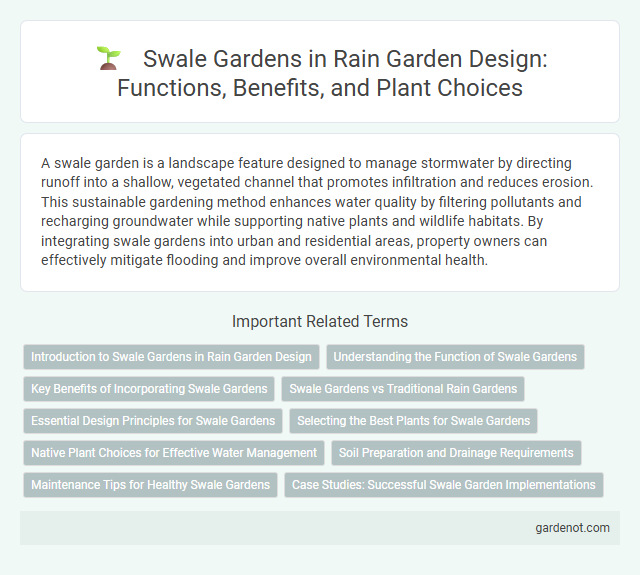A swale garden is a landscape feature designed to manage stormwater by directing runoff into a shallow, vegetated channel that promotes infiltration and reduces erosion. This sustainable gardening method enhances water quality by filtering pollutants and recharging groundwater while supporting native plants and wildlife habitats. By integrating swale gardens into urban and residential areas, property owners can effectively mitigate flooding and improve overall environmental health.
Introduction to Swale Gardens in Rain Garden Design
Swale gardens are shallow, vegetated channels designed to manage stormwater runoff within rain garden systems, promoting infiltration and reducing erosion. These linear landscape features integrate native plants and permeable soils to capture, filter, and slowly release water, enhancing groundwater recharge and improving water quality. Swale gardens effectively mitigate flooding risks by directing excess rainwater away from impervious surfaces and into natural drainage pathways.
Understanding the Function of Swale Gardens
Swale gardens are shallow, vegetated channels designed to manage stormwater runoff by slowing its flow and promoting infiltration into the soil. They filter pollutants, reduce erosion, and recharge groundwater while supporting diverse plant species that thrive in moist conditions. Implementing swale gardens enhances urban water management by mitigating flooding and improving water quality in surrounding ecosystems.
Key Benefits of Incorporating Swale Gardens
Swale gardens enhance stormwater management by directing and infiltrating runoff, reducing erosion and flooding risks. They improve water quality by filtering pollutants and sediments through vegetation and soil layers. Integrating swale gardens promotes groundwater recharge and supports local biodiversity, creating sustainable urban landscapes.
Swale Gardens vs Traditional Rain Gardens
Swale gardens differ from traditional rain gardens by incorporating elongated, shallow channels designed to slow and direct stormwater runoff, enhancing infiltration along the swale's length. Unlike the typically basin-shaped rain gardens, swale gardens effectively manage larger volumes of water and promote sediment capture while reducing erosion risks. Their linear design integrates seamlessly into landscapes, making them ideal for guiding water flow across slopes or between impervious surfaces.
Essential Design Principles for Swale Gardens
Swale gardens require careful contouring to direct stormwater flow effectively, ensuring infiltration and reducing runoff. Incorporating native vegetation with deep root systems enhances soil stability and maximizes water absorption. Proper grading and filter strip integration prevent erosion and promote pollutant filtration, making these design principles crucial for sustainable swale garden performance.
Selecting the Best Plants for Swale Gardens
Selecting the best plants for swale gardens involves choosing species that tolerate periodic flooding and improve water infiltration. Native grasses, sedges, and wetland plants such as Carex, Juncus, and Lobelia thrive in swales by stabilizing soil and filtering pollutants. Deep-rooted plants help enhance soil structure and support the swale's function in stormwater management.
Native Plant Choices for Effective Water Management
Swale gardens utilize native plants such as Eastern Redbud, Switchgrass, and Buttonbush to enhance water absorption and reduce runoff effectively. These species are adapted to local climate and soil conditions, promoting deep root growth that stabilizes soil and filters pollutants. Incorporating native plants in swale gardens improves groundwater recharge and supports local biodiversity.
Soil Preparation and Drainage Requirements
Swale gardens require well-drained, loamy soil amended with organic matter to enhance infiltration and support plant health. Soil preparation involves grading the area to create a shallow trench that channels stormwater while preventing erosion. Proper drainage is essential, often achieved by incorporating layers of sand and gravel beneath the planting bed to facilitate water percolation and avoid standing water.
Maintenance Tips for Healthy Swale Gardens
Regularly inspect swale gardens to remove debris and prevent clogging, ensuring optimal water flow and soil absorption. Maintain native vegetation by trimming overgrowth and replacing plants prone to disease to support a balanced ecosystem and erosion control. Monitor soil moisture levels and amend soil with organic matter when necessary to enhance drainage and nutrient retention for healthy plant growth.
Case Studies: Successful Swale Garden Implementations
Swale garden implementations in urban areas demonstrate effective stormwater management by capturing runoff and enhancing groundwater recharge, as seen in Portland, Oregon's innovative design reducing local flooding by 40%. The Minneapolis Green Infrastructure Initiative reported a 30% improvement in water quality through strategically placed swale gardens along transportation corridors. These case studies highlight the role of swale gardens in sustainable urban planning, reducing erosion, and supporting native plant biodiversity.
Swale garden Infographic

 gardenot.com
gardenot.com